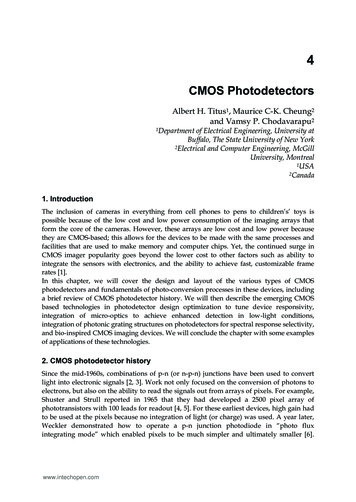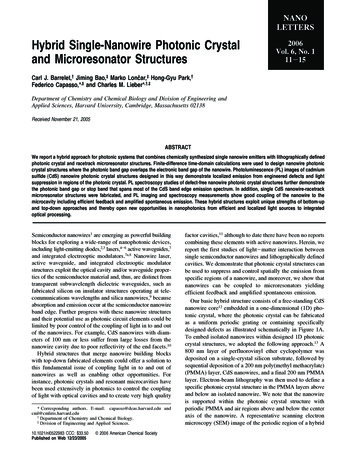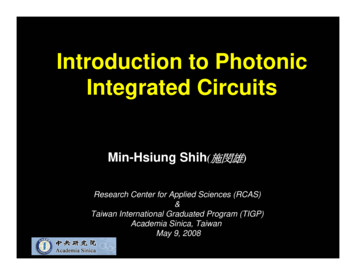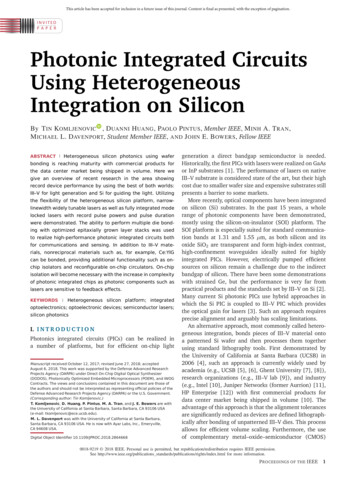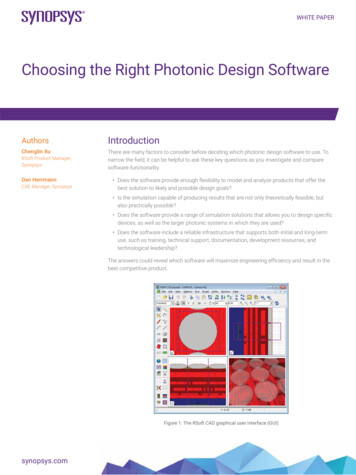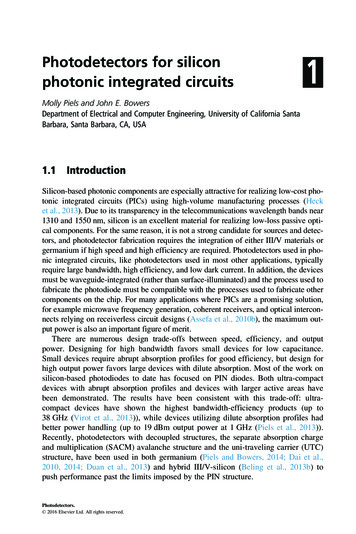
Transcription
Photodetectors for siliconphotonic integrated circuits1Molly Piels and John E. BowersDepartment of Electrical and Computer Engineering, University of California SantaBarbara, Santa Barbara, CA, USA1.1IntroductionSilicon-based photonic components are especially attractive for realizing low-cost photonic integrated circuits (PICs) using high-volume manufacturing processes (Hecket al., 2013). Due to its transparency in the telecommunications wavelength bands near1310 and 1550 nm, silicon is an excellent material for realizing low-loss passive optical components. For the same reason, it is not a strong candidate for sources and detectors, and photodetector fabrication requires the integration of either III/V materials orgermanium if high speed and high efficiency are required. Photodetectors used in phonic integrated circuits, like photodetectors used in most other applications, typicallyrequire large bandwidth, high efficiency, and low dark current. In addition, the devicesmust be waveguide-integrated (rather than surface-illuminated) and the process used tofabricate the photodiode must be compatible with the processes used to fabricate othercomponents on the chip. For many applications where PICs are a promising solution,for example microwave frequency generation, coherent receivers, and optical interconnects relying on receiverless circuit designs (Assefa et al., 2010b), the maximum output power is also an important figure of merit.There are numerous design trade-offs between speed, efficiency, and outputpower. Designing for high bandwidth favors small devices for low capacitance.Small devices require abrupt absorption profiles for good efficiency, but design forhigh output power favors large devices with dilute absorption. Most of the work onsilicon-based photodiodes to date has focused on PIN diodes. Both ultra-compactdevices with abrupt absorption profiles and devices with larger active areas havebeen demonstrated. The results have been consistent with this trade-off: ultracompact devices have shown the highest bandwidth-efficiency products (up to38 GHz (Virot et al., 2013)), while devices utilizing dilute absorption profiles hadbetter power handling (up to 19 dBm output power at 1 GHz (Piels et al., 2013)).Recently, photodetectors with decoupled structures, the separate absorption chargeand multiplication (SACM) avalanche structure and the uni-traveling carrier (UTC)structure, have been used in both germanium (Piels and Bowers, 2014; Dai et al.,2010, 2014; Duan et al., 2013) and hybrid III/V-silicon (Beling et al., 2013b) topush performance past the limits imposed by the PIN structure.Photodetectors. 2016 Elsevier Ltd. All rights reserved.
4PhotodetectorsIn this chapter, we will review the status of heterogeneous integration of siliconwaveguides and photodetectors. First, we will cover available fabrication technologies (both Ge and hybrid III/V-silicon). We will then discuss the design constraintsthat are common to all waveguide photodiodes on silicon substrates. We will present an overview of demonstrated devices, and lastly conclude and show an outlookfor the future.1.2TechnologyWaveguide photodiodes on silicon broadly fall into one of two categories:germanium-based and hybrid III/V-silicon. A number of groups have demonstratedGe-based photodiodes in mature fabrication technology based on a CMOS pilot line(Assefa et al., 2010a; Marris-Morini et al., 2014; Galland et al., 2013). In theseworks, the photodiodes have been cofabricated with passive optics, modulators, andin some cases transistors, but not optical sources (lasers or LEDs). On the otherhand, hybrid or InGaAs-based photodiodes have generally been fabricated usingtechnology that is further from mass-production capabilities, but that has a fulllibrary of components (competitive with InP substrate-based devices) available(Koch et al., 2013).1.2.1 GermaniumGermanium is an appealing absorbing material for use in silicon-based PICsbecause it can be integrated into a CMOS pilot line relatively easily (Si/Ge alloyedcontacts are already used in CMOS electronics) and because the bulk material isabsorbing in the entire 1310 nm window and much of the C and L bands. There area number of ways to integrate germanium and silicon, but selective area growth bychemical vapor deposition is the most common for waveguide photodiodes (Michelet al., 2010). The Si/Ge interface is conductive, and for vertical diodes, one contactis often composed of silicon. A typical geometry is shown in Figure 1.1a. There isa 4% lattice mismatch between germanium and silicon, which is relieved through(a)(b)Si/Ge waveguide PDHybrid III/V-silicon waveguide PDTop contactTop contactSide contactGe AbsorberSide contactInGaAs absorberSi rib WGBuried oxideInPSi rib WGBuried oxideSubstrateSubstrateFigure 1.1 Cross-section schematics of waveguide photodiodes on (a) Si/Ge and (b) hybridIII/V-silicon. A vertical diode configuration is shown here, but the diode can also be formedlaterally.
Photodetectors for silicon photonic integrated circuits5the formation of threading defects (Hartmann et al., 2005). These threading defectsform mid-gap generation-recombination centers, which increase the dark current ofthe detector relative to a bulk Ge diode (Mueller, 1959; Giovane et al., 2001). Thethreading defects also pin the Fermi level in their immediate vicinity, and thus forvertical PIN diodes, the p-down configuration is preferred (Masini et al., 2001).Germanium epitaxially grown on silicon has superior properties to bulk germanium for a C-band or L-band detector. After growth is completed, as the wafer iscooled from the growth temperature to room temperature, the thermal expansioncoefficient mismatch between the two materials results in the formation of tensilestrain in the germanium (Liu et al., 2004). This decreases the direct bandgapenergy, pushing the direct band edge to around 0.782 eV or lower (1599 nm).1.2.2 Hybrid III/V-siliconThe hybrid III/V-silicon platform enables the inclusion of optical gain in PICs.The III/V layer stack is usually bonded to the SOI waveguide, but can also beepitaxially grown on Si (Liu et al., 2014). For oxygen plasma enhanced bonding,lattice mismatch does not cause threading defect formation. Thus, any III/V material that can be grown on InP or other III-V substrates, including material withoptical gain, can be used in a hybrid III/V-Si PIC. For low temperature oxygenplasma enhanced bonding, the Si/InP interface is not conductive, and both sidesof the diode must be in the III/V layers. This results in most devices having thegeometry shown in Figure 1.1b. The InP contact layer thickness affects the optical properties of the device, and is typically around 200 nm. For higher temperature bonding, conduction through the interface is possible (Hawkins et al., 1997;Tanabe et al., 2012).It is possible to use the same epitaxial material for both a laser/amplifier and aphotodiode, and this was the approach pursued by the first hybrid III/V-silicon photodiode demonstration (Park et al., 2007). However, in this case, the quantum welldepth affects both amplifier performance and photodiode bandwidth, and it is difficult to optimize both simultaneously (Højfeldt and Mørk, 2002). Instead, for applications requiring high bandwidths, InGaAs lattice-matched to InP is the absorbingmaterial of choice. Fabricating hybrid III/V-Si PICs using multiple epitaxial materials is more complex than using a single material (Chang et al., 2010), but has beensuccessfully demonstrated (Koch et al., 2013).The germanium absorption coefficient in the C and L-bands is a function ofgrowth conditions, but it is typically around 3000 cm21 in the C-band with a longwavelength cutoff around 1600 nm. InGaAs is direct gap and has a larger absorption coefficient in the C-band (around 9600 cm21), and absorbs well in the entireL-band independent of growth conditions. The real part of the refractive index isrelatively low (about 3.6 as opposed to 4.2), which can make designing short, compact devices more difficult in the hybrid platform. However, InP offers greater flexibility in band engineering and optical matching layer design due to the availabilityof more mature growth technology.
6Photodetectors1.2.3 Other technologiesThere are a number of other promising technologies for fabricating photodiodes onsilicon platforms. Photodiodes based on defect-enhanced absorption in silicon havebeen demonstrated, and are promising for monitoring purposes (Knights andDoylend, 2008). To move the Ge band edge toward longer wavelengths, Sn hasbeen incorporated in the growth (Roucka et al., 2011), but waveguide-integratedGeSn photodiodes have yet to be demonstrated. InGaAs has been grown epitaxiallyon (Feng et al., 2012) and fused to (Black et al., 1997) silicon, resulting in a conductive interface. In both cases, the dark current is increased relative to lowtemperature bonded and native-substrate material. For optical interconnect applications, InGaAs nanopillars grown on silicon substrates have shown good performance as both photodetectors and optical sources (Chen et al., 2011).1.3Optical properties of Si-based WGPDsThere are two commonly used schemes for coupling to a waveguide photodiode:butt-coupling and vertical coupling. In a butt-coupled photodiode, the absorbingregion sits in a recess at the end of the input waveguide. Vertically-coupled photodiodes have an absorbing region that lies on top of the input waveguide. The fabrication process for butt-coupled photodiodes is typically more complex than thefabrication of vertically-coupled photodiodes and most practical when the absorbingregion is grown, rather than bonded. The primary benefit of the butt-coupled photodiode is that the confinement of the optical mode in the absorbing region is veryhigh, and thus ultra-compact devices with high efficiency and low capacitance canbe fabricated. The highest bandwidth-efficiency products for waveguide photodiodes on silicon reported to-date have been for butt-coupled devices (Virot et al.,2013; DeRose et al., 2011). In addition to a less complicated fabrication process,vertically coupled photodiodes typically have a larger active device area. Thismakes it relatively difficult to achieve high bandwidth and low dark current, but ispreferable for applications requiring high saturated output power (e.g., microwavephotonics and coherent communications).Whereas the optical design of butt-coupled detectors is straightforward (Bowersand Burrus, 1986), the optical design of vertically coupled photodetectors on siliconrequires careful simulation. Cross-section schematics of both InGaAs andgermanium-based waveguide photodiodes are shown in Figure 1.1. In both cases,the absorbing region has a real refractive index that is larger than the real refractiveindex of silicon, so the fundamental mode in the detector area has low overlap withthe input mode from the input passive waveguide. Thus the coupling from the inputpassive waveguide is typically to higher-order modes in the photodiode area. Theabsorption profile depends on the confinement factor of the higher-order mode inthe absorbing region and the overlap between it and the input mode, both of whichare functions of the absorber thickness. The end result is that the absorption profileof the device is a strong function of absorbing region thickness. The efficiency of a
Photodetectors for silicon photonic integrated circuits7device of a given length displays local maxima and minima, as shown inFigure 1.2a for germanium and Figure 1.2b for InGaAs. The simulation was doneusing the semi-vectorial beam propagation method for a TE-polarized input.On both material platforms, the absorption profile also depends on the underlying silicon thickness, waveguide width, input polarization, and wavelength. Inthe Si/Ge system, the locations of the maxima and minima are roughly the samefor both polarizations over large optical bandwidths. Thus devices with lowpolarization-dependent responsivity and high efficiency over an optical bandwidth in excess of 100 nm have been demonstrated (Yin et al., 2007). On thehybrid III/V-silicon platform, performance is more sensitive to design parameters. This is for a number of reasons, primary among them is that the real partof the refractive index of InGaAs is closer to the real part of the refractive indexof Si and the imaginary part is large enough to affect the confinement factor.The drawback of this sensitivity is that optical simulations of hybrid silicondevices require excellent material models in order to accurately predict performance, whereas approximate models often work well for Si/Ge detectors (Pielset al., 2013; Yin et al., 2007).The absorption characteristics are very important to determining how designtrade-offs between efficiency, bandwidth, and output power behave. For some typesof waveguide detectors (e.g., butt-coupled), a minor change in absorber thicknesswill have either no impact or an easily mitigated impact on the absorption profile.The peak/valley behavior in Figure 1.2, on the other hand, means that for verticallycoupled waveguide photodiodes on silicon, the optical and the electrical designmust be done .60.40.200.20.4 0.6 0.8Ge height (µm)0.4Si width: 2.0:0.8 µm0.2Si thickness:1.3:0.5 µm00.61000.51InGaAs height (µm)1.5Figure 1.2 Simulated quantum efficiency of a 20 μm-long TE photodetector as a function of(a) Ge thickness and (b) InGaAs thickness for waveguide detectors on silicon. For the Si/Gephotodetector, the underlying silicon thickness is the parameter; the dependence of theabsorption profile on width is minimal for easily fabricated device sizes (wider than 2 μm).For the hybrid III/V-Si detector, the parameter is the width of the silicon rib waveguide. Thethickness and rib height are assumed to be 500 and 250 nm, respectively, as these dimensionsare often used for this kind of device.
8Photodetectors(a)(b)Saturation current (mA)60(t)4020(e) (j)0.250.5Efficiency0.751Hz(k)(t) G00(a) (b)(o)(n) (c)(q)(p)(o)(f)(r)(s)(h) (d)(s)(g)(m)(i) (s)mA20(l)800040100Si/GeButt-c. PINPINMSMUTCHybrid SiPINUTC10HzGzGH(a)zGHBandwidth (GHz)5030 1060(a) ηBW η80BW10000SCB500m(s)A GHz(s)P 100 mA10(s)(u)(s)GHz(o)(o)203040Bandwidth (GHz)50Figure 1.3 (a) Bandwidth-efficiency and (b) output power-bandwidth trade-offs fordemonstrated waveguide devices. Devices with avalanche gain are not included in theseplots. Contours for bandwidth-efficiency products of 10, 30, and 50 GHz are also shown in(a) and contours for saturation current-bandwidth products of 100, 500, and 1000 mA GHzare shown in (b). a: (Virot et al., 2013), b: (DeRose et al., 2011), c: (Liao et al., 2011),d: (Vivien et al., 2007), e: (Liu et al., 2006) (1520 nm), f: (Feng et al., 2009), g: (Wang et al.,2008; OpSIS), h: (Yin et al., 2007), i: (Masini et al., 2008) (divided optical bandwidthby O3), j: (Ahn et al., 2007) (divided optical bandwidth by O3), k: (Liow et al., 2013),l: (Assefa et al., 2009), m: (Assefa et al., 2013), n: (Chen and Lipson, 2009) (from pulsedmeasurement; f3dB 5 0.312τ FWHM (Weingarten et al., 1988)), o: (Piels and Bowers, 2014),p: (Binetti et al., 2010), q: (Lee et al., 2013), r: (Piels et al., 2014), s: (Beling et al., 2013b,t: (Bowers et al., 2010), u: (Ramaswamy, 2014).1.4Demonstrated waveguide photodiodes on siliconThis section presents the state of the art on waveguide photodetectors on silicon,organized by cross-section design. Figure 1.3a shows the electrical bandwidth andefficiency of a number of research devices on silicon. Unless otherwise indicated,the efficiency in the figure was measured at 1550 nm. The vertically-coupled PINdesigns, represented by red circles for Ge and blue crosses for hybrid silicon, offerease of fabrication for electrical bandwidths up to 30 GHz. For higher speeds, alternative approaches such as the butt-coupled PIN (orange rectangles), metalsemiconductor-metal (MSM; green diamonds) or UTC photodiode (blue triangles;purple crosses) have been necessary. Figure 1.3b shows the same electrical bandwidth and saturation current (the time-average current at 21 dB power compression) for the same set of devices. All devices shown are vertically-coupled, and thetrend illustrates the well-known saturation current-bandwidth trade-off.1.4.1 Vertically coupled PIN photodiodes in Si/Ge and InGaAsThe PIN diode is one of the most commonly used photodiode cross-section designs.In a PIN detector, most of the light is absorbed in the intrinsic region in the center
Photodetectors for silicon photonic integrated circuits(a)9(b)1402004040300.520Efficiency5060BW . η, BW (GHz)BW . η (GHz)60PD1030hgtlen20110(µm)0 0Ge0.5µm)ess (thickn000.20.40.60.8Ge thickness (µm)01Figure 1.4 (a) Bandwidth-efficiency product for a vertically-coupled Si/Ge PIN photodiodeas a function of intrinsic region thickness and device length. The assumed width is 3 μm. (b)Bandwidth, efficiency, and bandwidth-efficiency product for a 30 μm 3 3 μm verticallycoupled Si/Ge PIN photodiode as a function of intrinsic region thickness.of the device. For bandwidth, PIN design involves balancing the RC and the transittime limit. The RC limit is approximatelyfRC 512πðRs 1 RL ÞC(1.1)where Rs is the diode series resistance, RL is the load resistance (typically 50 Ω),and C is the diode capacitance, and the transit time limit is about (Bowers andBurrus, 1987)fτ 50:45vW(1.2)where v is the smaller of the saturated electron and hole velocities and W is theintrinsic region thickness. Since the diode capacitance is approximately εA/W,where A is the diode area, there is an optimum intrinsic region thickness.For vertically-coupled PIN photodiodes, the highest bandwidth-efficiency products can be obtained by choosing an absorption region thickness at a peak inFigure 1.2. This is shown for a Si/Ge PIN as a surface plot in Figure 1.4a. Thecalculation includes the transit time and RC limits assuming a 50 Ω load, butneglects parasitic effects. The capacitance was calculated using a parallel platemodel and a device width of 3 μm. The germanium region was assumed to becompletely depleted for both bandwidth estimates (i.e., the thicknesses of the pand n-contact were assumed negligible or had negligible absorption due to largerbandgap contact layers). The silicon waveguide height was 500 nm. The maximum values of bandwidth-efficiency product in Figure 1.4a are limited to below
10Photodetectors60 GHz because the optimum thicknesses for fast absorption do not necessarilycorrespond to thicknesses where the RC and transit time constants have been carefully balanced. This is shown (under the same assumptions used in Figure 1.4a) inFigure 1.4b for a 30 μm long device. For maximum bandwidth, the optimum germanium region thickness is 300 nm, but for maximum efficiency, 200 and 400 nmgive better performance.Despite these difficulties, several devices with good performance have beendemonstrated. The largest demonstrated bandwidth of a vertically-coupled PIN photodiode on Si/Ge is 27 GHz (Liow et al., 2013). Two Intel NIP photodiodes (Yinet al., 2007) had responsivities of 0.89 and 1.16 A/W at 1550 nm and electricalbandwidths of 26 and 24.1 GHz. A Luxtera device performed similarly, with aresponsivity of 0.85 A/W and bandwidth of 26 GHz (Masini et al., 2008). Finally,IME demonstrated photodetectors with a 20 GHz bandwidth and 0.54 A/W responsivity (Wang et al., 2008; OpSIS). The same group has recently demonstrated detectors with improved responsivity and the same bandwidth using (low-field)avalanche multiplication (Liow et al., 2013), and extended the 3 dB bandwidth byusing inductive gain peaking (Novack et al., 2013). It has proven difficult toincrease the bandwidth of a vertically coupled germanium PIN beyond 30 GHz in a50 Ω environment while maintaining high efficiency.The design space and results for hybrid III/V-silicon PIN photodetectors aresimilar to those for Si/Ge photodetectors. Optically, although the absorption profile can be altered by changing the width of the underlying silicon, achieving alarge change in confinement factor requires a very narrow waveguide, which inturn requires lithography with higher resolution than what has historically beenused to fabricate this kind of device. Electrically, the transit time-limited bandwidth of an InGaAs-based PIN detector is slightly lower and the RC-limited bandwidth is slightly higher than the same quantities for an equivalent Si/Ge PIN. Thisis because the hole velocity in InGaAs is slower than the carrier velocities in Ge,increasing the transit time, and the dielectric constant is lower, which decreasesthe capacitance. The performance of demonstrated devices is also similar to theperformance of Si/Ge PINs; a number of different devices have been demonstrated, and the bandwidths were all around 30 GHz (Binetti et al., 2010; Leeet al., 2013; Piels et al., 2014; Ramaswamy, 2014).Both Si/Ge and hybrid III/V-silicon PIN detectors have been investigated for usein high-power applications. The main limitations on output power are the activearea of the device and the maximum current density the cross-section can sustainbefore the internal field collapses (Williams and Esman, 1999). In the intrinsicregion of a photodetector, under low-injection conditions, there is a roughly constant electric field due to the applied bias that separates the charge carriers. As thecurrent density in the intrinsic region increases, the carriers screen the electric field.Under high injection, the field distribution redistributes with the minimum occurring in the intrinsic region. The maximum current density is reached when the minimum of the electric field drops below the value necessary for the carriers to be ableto maintain their saturation velocities. For a PIN photodetector, this can beexpressed as (Piels, 2013)
Photodetectors for silicon photonic integrated circuitsJmax 56εvn vpðVbi 1 VPD 2 Ecrit WÞn 1 vp ÞW 2 ðv11(1.3)where ε is the dielectric constant of the intrinsic region, vn and vp are the saturatedelectron and hole velocities, W is the intrinsic region width, Vbi is the diode built-involtage, VPD is the voltage drop across the device due to the load resistance andapplied bias, and Ecrit is the electric field at which the carrier velocities saturate.The factor 6εvn vp Wi2 ðvn 1 vp Þ determines how the saturation current scales withbias voltage, and should be as large as possible for high-power conversion efficiency (Tulchinsky et al., 2008). In germanium, it is 2.6e 2 5 A/V/cm2, while forInGaAs it is 2.3e 2 5 A/V/cm2, and so we expect slightly better power handlingfrom a Si/Ge PIN than from an InGaAs PIN with the same dimensions at the samebias voltage. However, the breakdown field of InGaAs is about twice that of Ge, soin the absence of a system limit on bias voltage (and neglecting thermal effects),the InGaAs device would have a larger saturated output power.1.4.2 Butt-coupled PIN photodiodes in GeOne approach to increasing the bandwidth beyond 30 GHz is to use a butt-coupledor nearly butt-coupled design (Virot et al., 2013; DeRose et al., 2011; Liao et al.,2011; Vivien et al., 2007; Feng et al., 2009). The confinement factor in the germanium for these photodiodes is nearly 100% regardless of the total germanium thickness used. As a result, most of the light can be absorbed by very short (less than10 μm long) devices. The highest bandwidths for waveguide photodiodes on siliconto date have been reported for ultra-compact butt-coupled PIN detectors.The optical characteristics of the device are relatively insensitive to the germanium thickness and device width, so a large degree of electrical optimization is possible. Due to their small size, the capacitance of ultra-compact devices is usuallyvery small, regardless of the intrinsic region thickness. This enables the use of verythin intrinsic regions for decreased transit time and operating voltage. There is asignificant fabrication challenge in getting the contact resistance low enough forhigh bandwidth in a 50 Ω environment, but in large part these are being advocatedfor applications where a larger series resistance may be acceptable. The primarydisadvantage of such ultra-compact designs comes in power handling. Due to thesmall active device area, the maximum output power is expected to be low.1.4.3 MSM photodetectorsAnother way to increase the bandwidth is to use a cross-section design with lowercapacitance per unit area. MSM detectors have this property, and have been demonstrated on Si/Ge. IBM successfully integrated a germanium-based photodiode witha 38 GHz bandwidth into a CMOS process flow, though the responsivity at1550 nm was only 0.07 A/W (Assefa et al., 2009). The same group integrated similar devices with higher responsivity and lower bandwidth with TIAs (Assefa et al.,
12Photodetectors2013). They also showed that it is possible to use such a structure in avalanchemode at low (1.5 V) bias, which yields a significant sensitivity improvement, whilemaintaining a 30 GHz bandwidth (Assefa et al., 2010c). Chen and Lipson demonstrated a device with 40 GHz bandwidth and higher (0.35 A/W) responsivity fabricated using wafer-bonding (Chen and Lipson, 2009). For both devices, because thegermanium is not grown on silicon using CVD, the responsivity begins to roll off atrelatively short wavelengths. In general, MSM devices can have lower capacitanceper unit area than PIN detectors because the depletion region only occupies a fraction of the device area. One consequence of this is that the saturation current density is also decreased. In addition, the dark current of MSM detectors is oftenhigher than the dark current of PIN diode-based devices.1.4.4 SACM avalanche photodiodesFor the lowest noise receivers, photodetectors with gain are attractive, using eitheravalanche or photoconductive gain. Silicon is an excellent material for avalanchegain due to the low electron and hole ionization coefficient ratio (k , 0.1), whichallows for high gain-bandwidth products and low excess noise factors. SACM avalanche photodetectors (APDs) using silicon avalanche regions have been demonstrated using both III-V (Hawkins et al., 1997) and Ge (Dai et al., 2010) absorbingregions. In the surface-normal configuration, gain-bandwidth products up to840 GHz (Sfar Zaoui et al., 2009) have been demonstrated in for Si/Ge devices andup to 315 GHz (Hawkins et al., 1997) have been demonstrated for III-V/Si ones. Aswaveguide detectors, the highest gain-bandwidth product was at least 380 GHz(Duan et al., 2013) (20 GHz, gain . 19).1.4.5 Si/Ge UTC photodiodesThe UTC cross-section is an alternative way to push the bandwidth of a waveguideSi/Ge photodiode beyond 30 GHz in a vertically-coupled configuration withoutdecreasing the active device area. A UTC is a decoupled structure where theabsorption occurs in a doped layer and carriers are collected through a depletedlayer in the silicon. As a result, the germanium thickness can be chosen for optimalcoupling from the silicon waveguide without affecting the capacitance, andvertically-coupled devices with relatively large footprints and fast transit times canbe fabricated without sacrificing RC performance. Recently, Si/Ge UTCs with abandwidth of 40 GHz and responsivity of 0.5 A/W have been demonstrated (Pielsand Bowers, 2014).The cross-section and band diagram of the devices in Piels and Bowers (2014)are shown in Figure 1.5. The transit time is dominated by minority electron transport through the absorber and collector (holes in the absorber move to screen theminority charges), which is the origin of the term uni-traveling (Ishibashi et al.,1997). In the absorber, photogenerated carriers move toward the collector by a combination of diffusion and drift; the absorber is doped on a grade to produce a smallelectric field and decrease the transit time. In the collector, injected minority
Photodetectors for silicon photonic integrated circuits13Figure 1.5 (a) Band diagram and (b) cross-section schematic of a waveguide Si/Ge unitraveling carrier photodetector.Source: Reprinted with permission from Piels and Bowers (2014).electrons form a drift current (from the electric field due to the bias voltage) andare collected at the n-contact. Unlike PIN diodes in Si/Ge, UTC detectors performbetter when they are p-side up. The threading defects that form at the Si/Ge heterointerface pin the Fermi level in that region, but if the germanium is doped sufficiently highly, this does not result in the formation of a large barrier (Piels andBowers, 2014).UTC photodiodes were first demonstrated in III/V materials, where they havebeen shown to have superior bandwidth and power handling due to the large electron velocity in InP relative to the hole velocity. In group IV materials, electron andhole velocities are similar, and the benefit of the UTC is instead that it allows us tochoose a capacitance per unit area independently from the absorbing region thickness. For the absorption peak at 200 nm Ge thickness, this results in a higherbandwidth-efficiency product. In a UTC photodiode, the transit time is dominatedby the electron transport properties and the capacitance is dominated by the collector thickness. The material constants in Eqs (1.1) and (1.2) change, and Eq. (1.3)becomes (Mishra and Singh, 2008)Jmax 52εvnðVbi 1 VPD 2 Ecrit WÞW2(1.4)where ε now refers to the dielectric constant of the silicon collector and W is itsthickness.Figure 1.6a shows idealized design curves for bandwidth and efficiency for PINand UTC photodiodes assuming a 200 nm thick absorber and a 3 μm wide mesa.Parasitic effects (e.g., pad capacitance and diode series resistance) are neglected inthe simulation. The collector thickness of the UTC was chosen separately for eachdetector length to maximize the bandwidth-efficiency product. As the figure shows,for even moderate efficiency, the UTC out-performs the PIN. F
photonics and coherent communications). Whereas the optical design of butt-coupled detectors is straightforward (Bowers and Burrus, 1986), the optical design of vertically coupled photodetectors on silicon requires careful simulation. Cross-section schematics of both InGaAs and germanium-based waveguide photodiodes are shown in Figure 1.1. In .
